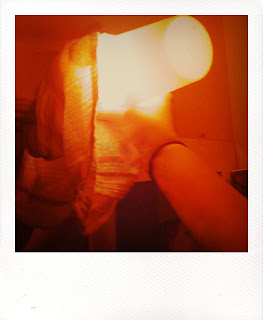
Hello everyone! As you know, I don't post much here because it isn't that often that I have new info about film to share. I laugh out loud thinking about what has happened today. My new friend, Becca Dryer, and I got together to chat film. She shot her first roll the other day and I couldn't be more proud!
She has a Holga (I have been wanting one forever), and she agreed to let me shoot a roll with it. I need some new head shots so I used the my roll trying to get some self portraiture going. We will see how that goes. Anyway, after looking at her little Holga book, we found out that you can use 35mm film in a Holga and it will take panoramic pictures. We were anxious to try this, but had some difficulty figuring out how to get the film back into the 35mm film canister after we had taken the pictures. We thought we could put a red cup over the light in my bathroom and load the film into another camera and manually wind it back into the canister. The photo above is a picture of our makeshift dark room. Taken by Becca with her handy iphone. Yes, that is my hand holding up a red cup over the bathroom light.
We made that transfer and were feeling very proud of ourselves until we got the film back from one hour Walgreens and learned that is was all overexposed beyond recognition. Oops! Chalk that one up to learning. It all just seems so silly now, I laugh every time!
The self portraits were on a different roll and I will post them as soon as they get back from the lab. Fingers crossed!







